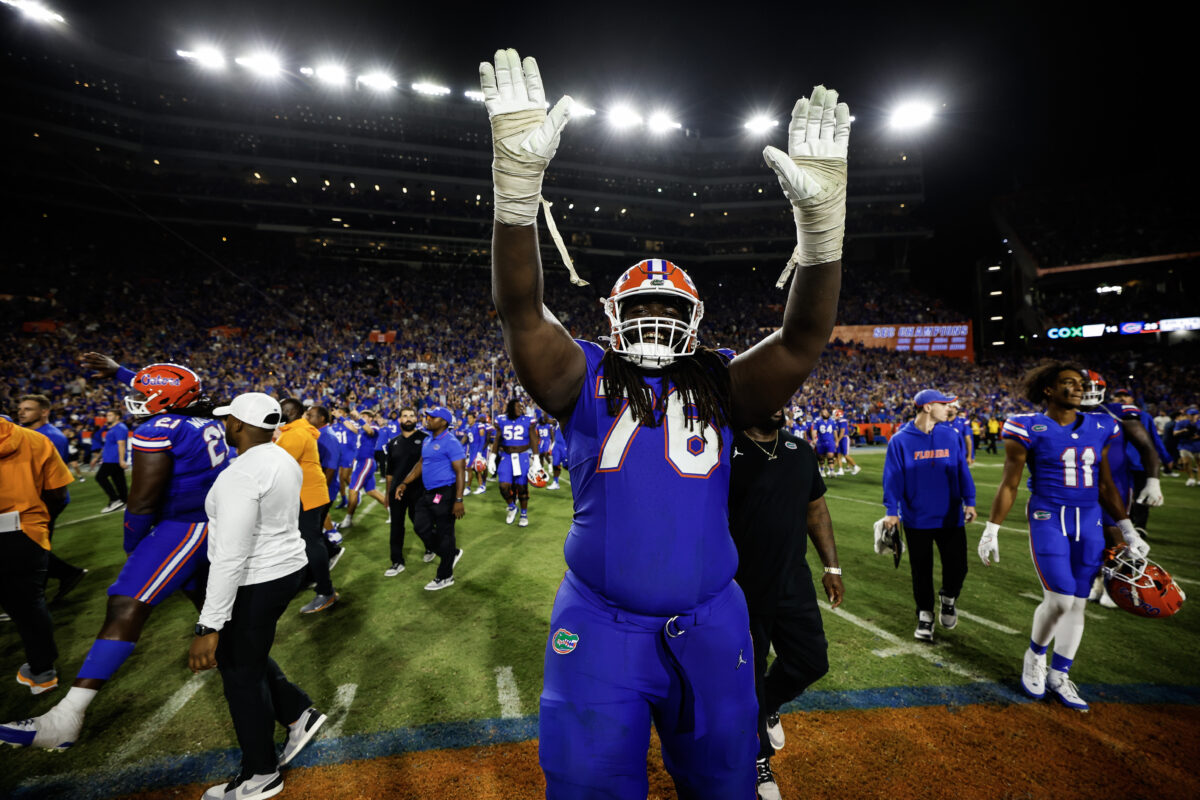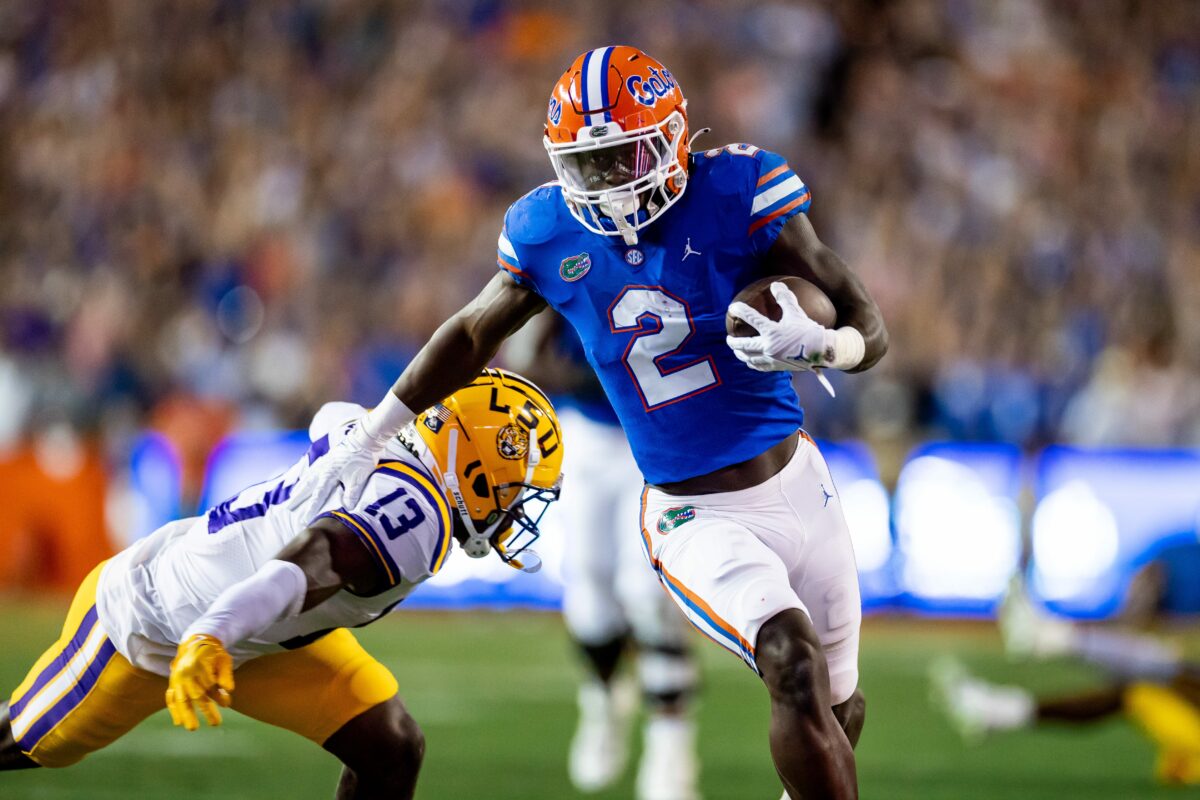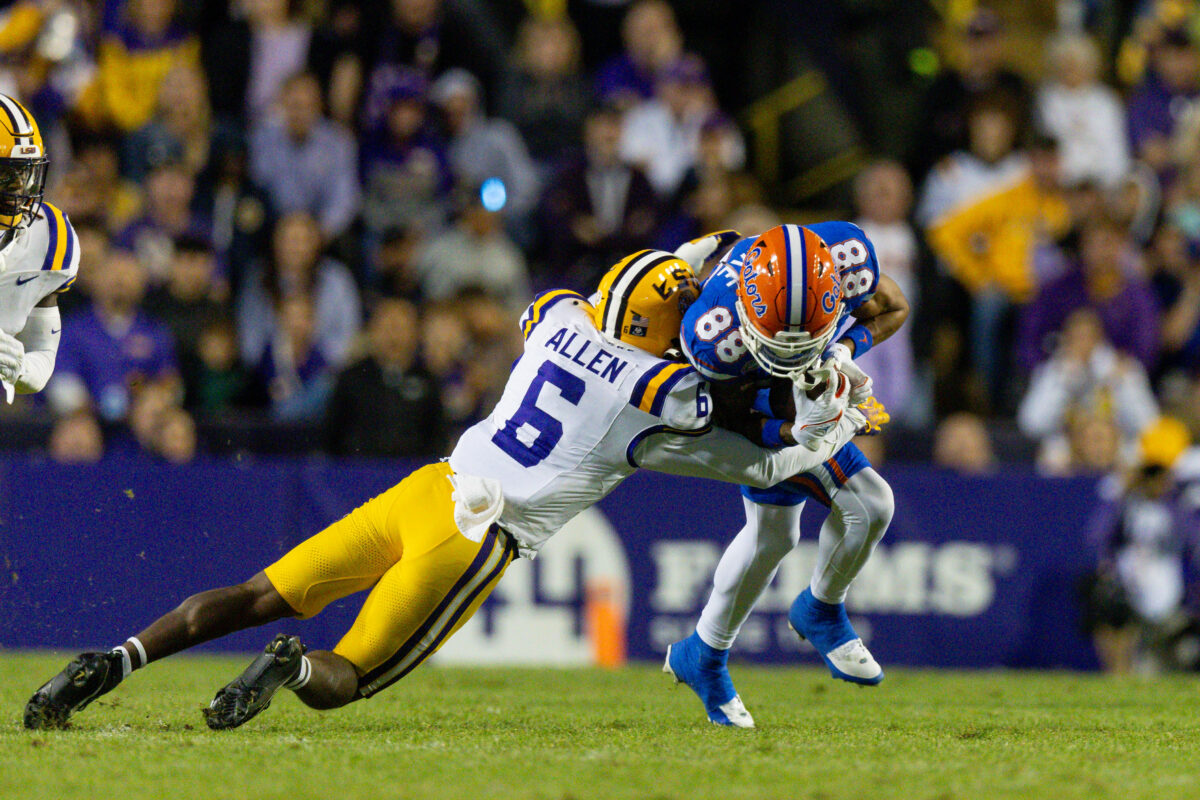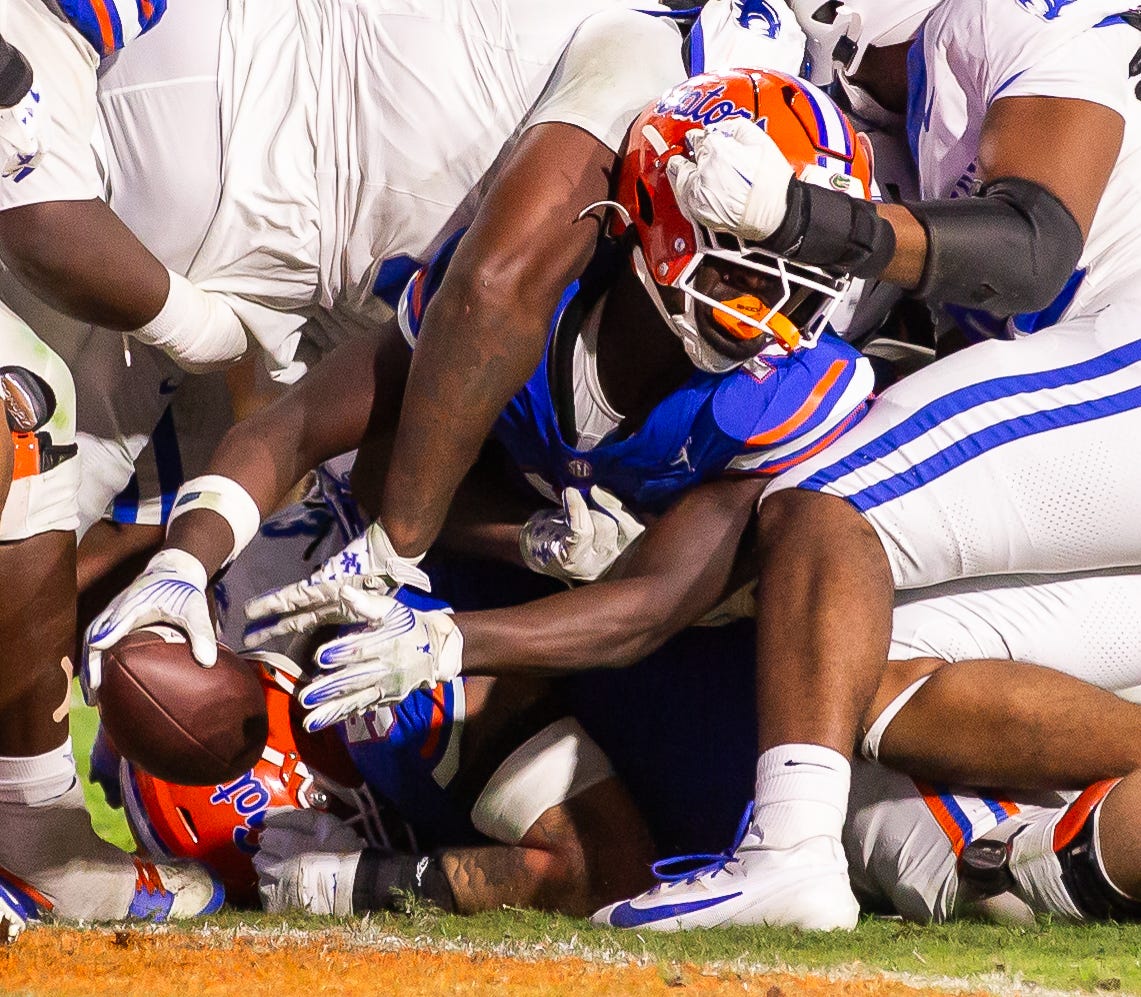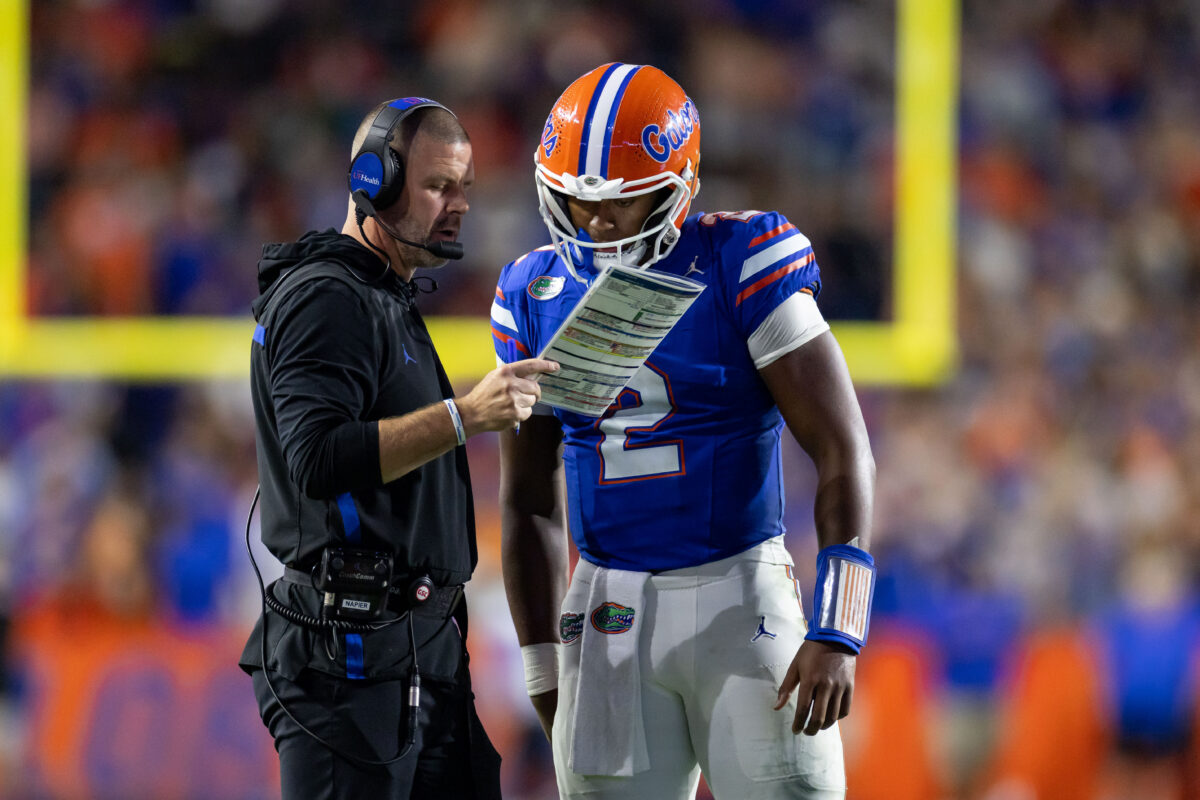Florida’s run game against UCF was far from perfect, but Pro Football Focus gave the Gators their highest run grade (68.1) since facing Samford (69.3) in Week 2.
Coming into the season, the rushing attack was thought to be Florida’s biggest strength, but the loss of Trevor Etienne has proved costly for the Orange and Blue. We can’t forget that lead back Montrell Johnson Jr. underwent minor knee surgery during fall camp.
It was a good bounce-back week for Johnson and the guys behind him following the bye. Let’s take a look at what Pro Football Focus had to say about the running backs and offensive line in Week 6.
Check out our breakdown of Florida’s passing game against UCF using PFF grades, too.
Running backs
Florida utilized a trio of running backs this week — [autotag]Montrell Johnson Jr[/autotag]. started the game and played 40 snaps, followed by true freshman [autotag]Jadan Baugh[/autotag] with 21 snaps and JUCO transfer [autotag]Ja’Kobi Jackson[/autotag] rounds out the list with six snaps.
The carries were split a bit differently, with Johnson getting 10 attempts, Baugh getting nine and Jackson getting three.
Johnson ran for 54 yards (5.4 per attempt) and a touchdown, earning a 69.6 overall grade and a 68.7 grade on run plays. Although neither of those figures led the rushing corps, Johnson was the most sure-handed rusher for Florida with a 73.4 fumble grade.
What’s most impressive about Johnson’s performance is that he gained 45 of his 54 yards after contact, forcing three missed tackles and breaking off a long run for 34 yards. However, any smart football fan will quickly point out that the bulk run saved him from an otherwise unseemly outing.
Johnson tried hitting all the holes, but he did most of his damage in the gap between the center and right guard.
Baugh put up the highest overall grade (73.5) and run grade (73.4) in the position room, but he only managed 30 yards on nine carries (3.3 yards per attempt). However, it’s the six forced missed tackles that stand out when going over his numbers. Baugh is proving to be an elusive back for Florida and could be the No. 1 instead of Treyaun Webb next season.
He likes going up the middle, hitting the gap on either side of the center, but he was most effective of the left end against UCF.
Jackson doesn’t get a ton of opportunities, but he always seems to do a lot when he gets on the field. In Week 6, Jackson ran for 25 yards on three carries (8.3 yards per attempt), and he scored a touchdown.
A chunk play for 19 yards accounts for the bulk of Jackson’s yards, but it’s still impressive to see him break those kinds of plays when he knows he’s only getting a handful of opportunities each game. Jackson earned a 65.2 overall grade and a 64.8 rushing grade this week.
Wide receiver Tank Hawkins also got a run in this week, going for four yards and earning a 57.9 run grade.
Quarterbacks
Florida’s quarterbacks tend to run a few times a game, be it a scramble or a designed run. Those designed runs usually go to DJ Lagway, but Graham Mertz had six carries this week, and only two of them were on scrambles.
Mertz ran for six yards on as many attempts, and Lagway went for 11 yards on three carries. Neither put up a strong run grade — 56.6 for Mertz and 53.3 for Lagway.
Mertz made the most of his scrambles, going for seven yards on two carries, but his keepers didn’t go as well — minus-5 yards over three carries. Mertz needs to make the right decision on those option plays a bit more often, based on these numbers.
Lagway is best when he scrambles (five yards on one carry) but his designed runs yield positive results as well (six yards on two carries). Keeping the true freshman healthy is paramount this season. Expect Lagway to run a bit more often when he’s fully in control of the offense next year.
Run Blocking
As usual, Gators Wire will discuss the offensive line from left to right. Remember, this analysis is mostly focused on run plays; however, we will provide overall grades as well to keep the bigger picture in mind.
Left Tackle
[autotag]Austin Barber[/autotag] delivered his best run-blocking performance of the year against UCF, posting a 70.8 grade over all 29 run plays Florida ran. Barber was more effective on gap runs (74.1) compared to zone runs (63.3).
The Gators never hit the left tackle in Week 6, but Barber was surely a factor on the five plays that went all the way out to the left end (beyond the tight end). Not coincidentally, Florida’s highest average came off the left end (7.4 yards per attempt).
Left Guard
[autotag]Knijeah Harris[/autotag] got the start for Florida at left guard, with Bryce Lovett as his backup.
Harris was excellent against the pass rush this week (85.1), but he struggled a bit more on run plays (63.2). He posted the lowest run-blocking grade among the five starters, but there’s a reason he stays out there. Harris was solid on zone runs (68.8) but struggled on gap plays (54.1).
Lovett only saw the field for seven run plays, and his numbers were terrible. A 43.8 run-blocking grade is almost half the 81.1 pass-blocking grade he put up, which explains why Harris is getting 30 more snaps a game. It also provides an explanation for Lovett’s brutal 48.7 overall grade on offense.
Florida rushers only hit the gap between the left tackle and left guard twice for one yard. The middle left gap (between the left guard and center) yielded better results (12 yards on four carries), but still isn’t the best option.
Center
[autotag]Jake Slaughter[/autotag] earned a 66.0 run-blocking grade against UCF — 69.1 on gap runs and 61.1 on zone plays. He ranked fourth overall on the team this week and third among offensive linemen. It’s his second-worst performance of the year as a run blocker, but he’s still incredibly solid overall.
We already talked about Slaughter helping to make runs to the middle-left effective, but it’s on the right side where he made the bigger difference. Florida rushers ran for 54 yards on eight runs between Slaughter and the right guard. If it ain’t broke, don’t fix it.
Right Guard
[autotag]Damieon George Jr[/autotag]. didn’t have the best day as a pass-blocker, but he was solid on run plays at right guard for Florida. George took the majority of the run plays (22) in front of Kamryn Waites (7) and earned the higher run-blocking grade (65.3). George was better on zone plays (68.0) than gap plays (58.1).
Waites only saw the field for zone runs, posting a 62.5 run-blocking grade.
Despite some pedestrian grades from PFF, Florida’s right guard tandem deserves some credit for the 58 yards gained off the middle-right gap. However, Florida rushers gained zero yards on two attempts to the gap between the right guard and right tackle.
Right Tackle
[autotag]Brandon Crenshaw-Dickson[/autotag] was Florida’s best offensive lineman against UCF, earning team-high grades all-around — 85.4 as a pass blocker and 74.3 as a run blocker. His 75.1 overall grade is second only to Graham Mertz throughout the entire offense.
Crenshaw-Dickson posted strong grades on both zone plays (72.5) and gap plays (67.5). Florida rushers ran off the right tackle just three times for eight yards, but that could be a weakside-strongside issue.
Tight Ends/Receivers
Florida runs a lot of two-tight-end sets, which means Arlis Boardingham and Hayden Hansen are asked to block quite often. Neither performed well as run blockers, posting grades of 52.3 and 55.2, respectively.
Hansen was decent on zone runs (64.1), but that’s not a big enough silver lining to save him.
Receivers aren’t expected to do much as run blockers, but Chimere Dike deserves a shoutout for his 74.1 run-blocking grade against UCF. He led the team on zone plays (77.2) and finished second overall behind BCD.
Understanding PFF grades
The grading scale ranges from minus-2 to plus-2 with increments of 0.5, and players are given a grade on every play they are on the field for. A zero grade means a player did his job, while the two ends of the scale represent extreme success or failure — think red zone interception at the end of a game or a game-winning touchdown pass when applying it to quarterbacks.
There’s a level of subjectivity to it, but each grade is reviewed at least once. Once all plus-minus grades are in, the numbers are converted to a 0-100 scale to easily compare players. There are some loosely defined tiers within the system — 90-100 is elite, 85-89 is Pro Bowl level for NFL players, 70 to 84 is a starter and 60-69 is a backup. Anything 59 and below is considered a replaceable talent.
Since we’re looking at college athletes with a system designed for the pros, we will consider anything above 65.0 as a solid performance.
Follow us @GatorsWire on X, formerly known as Twitter, and like our page on Facebook to follow ongoing coverage of Florida Gators news, notes and opinions.
